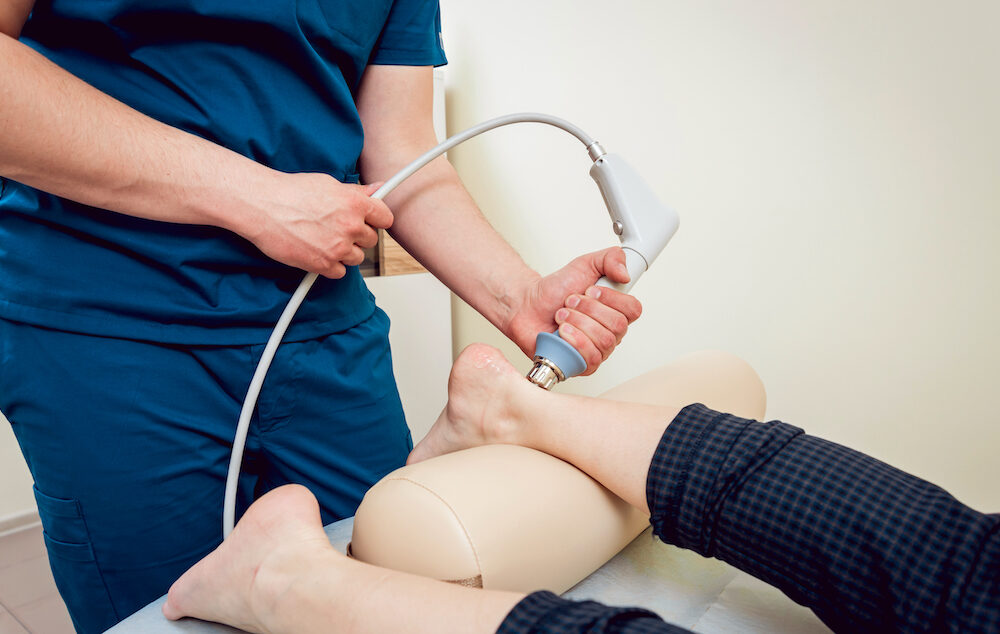Shockwave Therapy (ESWT) non-surgical solution to persistent problems

What are the benefits of Shockwave
Shockwave therapy stimulates the body’s natural healing process. There is actually an immediate reduction of pain and improved ease of movement. Secondary effects are minor. Shockwave therapy may also reduce the chance of further surgery.
Non-surgical solutions to persistent problems Extracorporeal Shock Wave Therapy (ESWT) is a non-invasive treatment where a hand-held device is applied outside the body, introducing energy to painful areas and promoting the body to heal itself. Regardless of the cause; injuries can be debilitating and, if left untreated, may affect your daily life. Shockwave is a nonsurgical, non-invasive treatment option for a wide variety of conditions with no downtime. In having a long-term injury many people think that surgery is their only option to get better but there is risk involved and a long recovery time associated with this. “Shockwave Therapy (ESWT) offers two main advantages over traditional surgical methods: fewer potential complications and a faster return to normal activity.” FDA Clinically proven Shockwave Therapy is clinically proven, recognised by the top orthopaedic hospitals and used by high-profile professional sports bodies. What are shockwaves? Shockwaves are high-energy sound waves which are transmitted to the affected area to accelerate healing. The treatment increases blood flow, decreases localised pain and stimulates cell regeneration – this encourages the body to repair itself. Shockwaves also break down injured tissue and calcifications.
What are the advantages with Shockwave Therapy?
- Shockwave therapy can be used in both chronic and acute conditions.
- Anaesthesia is not necessary
- It’s entirely non-invasive
- There is no medication involved
- It’s safe • Significant clinical benefit often seen 6-8 weeks after treatment
- Fast treatment times
How long does the treatment last?
6000 shocks are delivered per session, which last approximately 15 minutes.
Does the treatment hurt?
You may feel some discomfort or pain if the patient cannot tolerate the settings can be adjusted.
Is Shockwave painful? You may experience some discomfort during treatment but the pain should be tolerable. Due to the analgesic effect of Shockwave Therapy many patients report immediate pain relief following treatment. If you experience pain after treatment you may use ordinary non-prescription painkillers such as paracetamol. Do not use anti-inflammatory medication or Ibuprofen as both may interfere with the body’s self-healing process. Common indication Include: Achilles Tendonitis Plantar Fasciitis (Heel Pain) Patellar Tendonitis (Jumper’s Knee) Medial Tibial Stress Syndrome (Shin Splints) Epicondylitis (Tennis or Golfers Elbow) Periarticular Shoulder Pain Tendinosis Calcarea (Calcific Tendonitis) Greater Trochanteric Pain Syndrome (Hip) Back Pain How many sessions are needed? The amount of treatment sessions will vary dependant on the type of shockwave used and conditions being treated. As a general rule 3 – 6 treatment sessions is advised. As this is encouraging the body to heal itself your body will progress in the healing process even 2-3 months after treatment has stopped. How successful is the treatment? Statistics vary based on the condition being treated – varying from 60-90% success rate. Studies have shown 90% of patients with Achilles Tendonitis (Heel pain) will experience a full recovery or significant reduction in their pain and injury. Can Shockwave treat old/persistent injuries? Shockwaves can treat both long-term chronic conditions and newer injuries, there is a great deal of evidence to show that Shockwave Therapy can achieve great results even with historical conditions.
How many treatments will I need?
Protocol states that three treatments are necessary at weekly intervals; however additional treatments may be needed if authorized by your podiatrists.
What should I do if I am in pain after the treatment?
The shockwave will trigger an inflammatory response, For this reason, do not use anti-inflammatory medications. Do not use ice as we want our bodies to trigger the natural healing response. The pain should subside within 24 hours. Use Paracetamol if needed as long as you able to take this medication.
What if it feels good after the treatment?
Even if it feels good, we would advise you to take it easy, rest.

